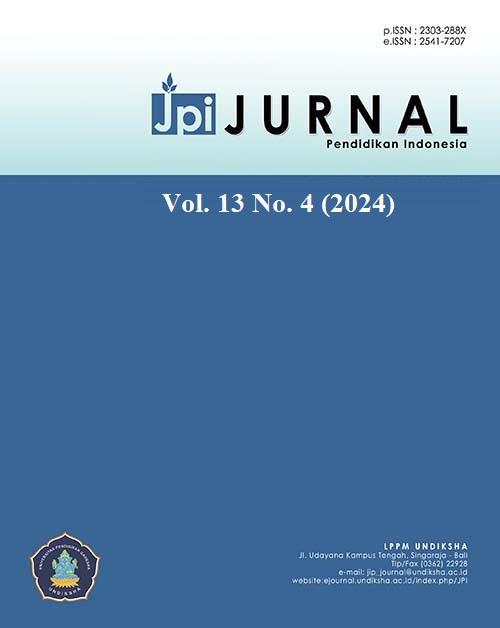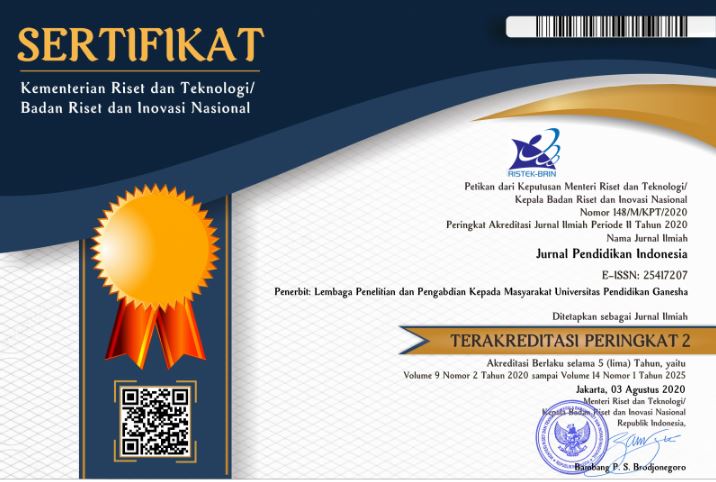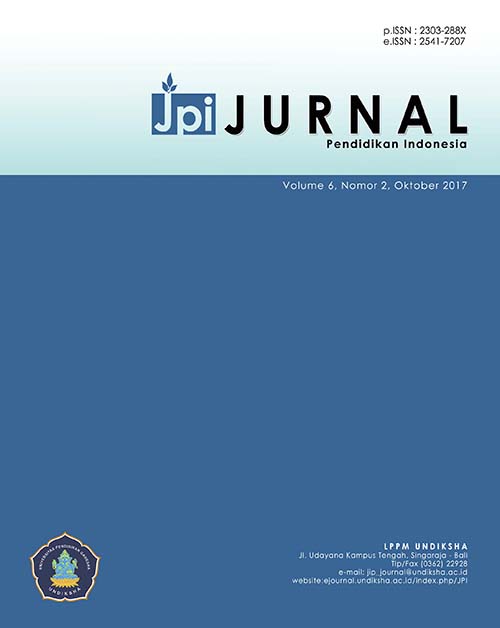Analisis Kesalahan Siswa Dalam Menyelesaikan Soal Model PISA Pada Domain Konten Berdasarkan Gaya Belajar
DOI:
https://doi.org/10.23887/jpiundiksha.v13i4.83526Kata Kunci:
Analisis Kesalahan, Soal Pisa, Domain Konten, Gaya BelajarAbstrak
Penelitian ini bertujuan untuk mendeskripsikan kesalahan siswa dalam menyelesaikan soal model PISA dalam domain konten yang yang ditinjau dari gaya belajarnya. Penelitian ini merupakan penelitian deskriptif eksploratif dengan pendekatan kuantitatif dan kualitatif. Sampel pada penelitian ini adalah 132 siswa SMA/MA. Sampel dalam penelitian ini ditentukan dengan teknik stratified proportional random sampling. Instrumen yang digunakan berupa soal model PISA dalam domain konten, angket gaya belajar. Analisis data dilakukan dengan menghitung persentase kesalahan berdasarkan hasil tes siswa, menguji perbedaan banyak kesalahan siswa dalam menyelesaikan soal model PISA ditinjau dari gaya belajar dengan menggunakan uji Anova. Hasil penelitian menunjukkan bahwa secara keseluruhan, kesalahan siswa dengan gaya belajar visual berada pada kategori sedang sementara kesalahan siswa dengan gaya belajar auditorial dan kinestetik berada pada kategori tinggi. Namun secara inferensial, tidak terdapat perbedaan yang signifikan dari banyaknya kesalahan siswa dalam menyelesaikan soal model PISA antara siswa dengan gaya belajar visual, auditorial, dan kinestetik.
Referensi
Adnan, M., Lee Abdullah, M. F. N., Ahmad, C. N. C., Puteh, M., Zawawi, Y. Z., & Maat, S. M. (2021). Learning Style And Mathematics Achievement Among High Performance School Students. World Applied Sciences Journal, 28(3), 392–399. Https://Doi.Org/10.5829/Idosi.Wasj.2013.28.03.643.
Agoestanto, A., Sukestiyarno, Y. L., Isnarto, R., & Lestari, M. D. (2018). The Position And Causes Of Students Errors In Algebraic Thinking Based On Cognitive Style. International Journal Of Instruction, 12(1), 1431–1444. Https://Doi.Org/10.29333/Iji.2019.12191a.
Akram, H. (2020). Learning Styles And Their Relation To Teaching Styles. International Journal Of Language And Linguistics, 2(3), 241. Https://Doi.Org/10.11648/J.Ijll.20140203.23.
Alhassora, N. S. A., Abu, M. S., & Abdullah, A. H. (2017). Newman Error Analysis On Evaluating And Creating Thinking Skills. Man In India, 97(19), 413–427.
Amir-Mofidi, S., Amiripour, P., & Bijan-Zadeh, M. H. (2022). Instruction Of Mathematical Concepts Through Analogical Reasoning Skills. Indian Journal Of Science And Technology, 5(6), 2916–2922. Https://Doi.Org/10.17485/Ijst/2012/V5i6.12.
Cassidy, S. (2019). Learning Styles: An Overview Of Theories, Models, And Measures. Educational Psychology, 24(4), 419–444. Https://Doi.Org/10.1080/0144341042000228834.
Clements, M. A. (2019). Analyzing Children’s Errors On Written Mathematical Tasks. Educational Studies In Mathematics, 11(2), 1–21.
Dasaprawira, M., Zulkardi, & Susanti, E. (2018). Developing Mathematics Questions Of Pisa Type Using Bangka Context. Journal On Mathematics Education, 10(2), 303–314.
Dewantara, A. H. (2019). Soal Matematika Model Pisa: Alternatif Materi Program Pengayaan. Didaktika : Jurnal Kependidikan, 12(8), 98. Https://Doi.Org/10.30863/Didaktika.V12i2.186.
Ganesen, P., Osman, S., Abu, S., & Kumar, J. A. (2018). The Relationship Between Learning Styles And Achievement Of Solving Algebraic Problems Among Lower Secondary School Students. International Journal Of Advanced Science And Technology, 29(9s), 2563–2574.
Hidayah, N. (2022). Students Activities In Solving Mathematics Verbal Questions Based On Vak Learnig Styles. Jurnal Daya Matematis, 3(2), 116. Https://Doi.Org/10.26858/Jds.V3i2.3226.
Imamuddin, M., Rusdi, I., & Audina, M. (2019). Kemampuan Pemecahan Masalah Matematika Siswa Berdasarkan Gaya Belajar. Al-Khawarizmi: Jurnal Pendidikan Dan Pembelajaran Matematika, 2(1), 5–10.
Ishartono, N., Faiziyah, N., Sutarni, S., Putri, A. B., Fatmasari, L. W. S., Sayuti, M., Rahmaniati, R., & Yunus, M. M. (2021). Visual, Auditory, And Kinesthetic Students: How They Solve Pisa-Oriented Mathematics Problems? Journal Of Physics: Conference Series, 1720(1), 45. Https://Doi.Org/10.1088/1742-6596/1720/1/012012.
James, W., & Gardner, D. (2021). Learning Styles: Implications For Distance Learning. New Directions For Adult And Continuing Education.
Johar, R. (2020). Domain Soal Pisa Untuk Literasi Matematika. Jurnal Peluang, 1(1), 30.
Munfarikhatin, A., Natsir, I., & Palobo, M. (2019). Students’s Obstacle In Solving Pisa Like Task: An Error Analysis. Advances In Social Science, Education And Humanities Research, 603(Icss), 431–437.
Nariyati, R. Y., Halini, H., Bs, A., & D. (2018). Literasi Matematis Siswa Pada Konten Change And Relationship Ditinjau Dari Gaya Belajar Siswa. Jurnal Pendidikan Dan Pembelajaran Khatulistiwa, 28(3), 1–9. Https://Doi.Org/Https://Jurnal.Untan.Ac.Id/Index.Php/Jpdpb/Article/View/21969.
O.E.C.D. (2018). Pisa 2018 Assessment And Analytical Framework. Oecd Publishing.
O.E.C.D. (2019). Pisa 2021 Mathematics Framework (Second Draft. Oecd Publishing.
Oluremi, F. D. (2018). Learning Styles Among College Students. International Journal For Cross-Disciplinary Subjects In Education (Ijcdse, 5(4), 2631–2640.
Pangestu, K. D. J., Zuhri, M. S., & Sugiyanti, S. (2019). Analisis Kesalahan Siswa Dalam Menyelesaikan Soal Cerita Berdasarkan Tahapan Pemecahan Masalah Polya Ditinjau Dari Gaya Belajar. Imajiner: Jurnal Matematika Dan Pendidikan Matematika, 3(3), 206–214. Https://Doi.Org/10.26877/Imajiner.V3i3.7547.
Parawansa, F. A., & Siswanto, R. D. (2021). Hambatan Epistemologi Peserta Didik Dalam Menyelesaikan Aritmatika Sosial Berdasarkan Gaya Belajar Dan Perbedaan Gender. Jurnal Cendekia : Jurnal Pendidikan Matematika, 5(3), 2532–2547. Https://Doi.Org/10.31004/Cendekia.V5i3.784.
Philominraj, A., Jeyabalan, D., & Vidal-Silva, C. (2016). Visual Learning: A Learner Centered Approach To Enhance English Language Teaching. English Language Teaching, 10(3), 54. Https://Doi.Org/10.5539/Elt.V10n3p54.
Pritchard, A. (2019). Ways Of Learning: Learning Theories And Learning Styles. Routledge.
Raiyn, J. (2018). The Role Of Visual Learning In Improving Students’ High-Order Thinking Skills. Journal Of Education And Practice, 7(24), 155–121. Www.Iiste.Org.
Rasitullah, S. A., & Wahyu, K. (2020). Analisis Kesalahan Siswa Dalam Menyelesaikan Soal Sistem Persamaan Linier Dua Variabel Di Tinjau Dari Gaya Belajar. Jurnal Syntax Transformation, 21(1), 1–9. Https://Doi.Org/10.1016/J.Solener.2019.02.027.
Reid, G. (2019). Learning Styles And Inclusion. Paul Chapman Publishing.
Safegi, J. D., Hiltrimartin, C., Sukaryawan, M., & Madang, K. (2020). Kesalahan Siswa Sekolah Menengah Pertama Dalam Menyelesaikan Soal Matematika Tipe Pisa (Vol. 3, Issue 2, Pp. 114–126). Https://Doi.Org/10.35438/Inomatika.
Safitri, E. L., Prayitno, S., Hayati, L., & Hapipi, H. (2018). Analisis Kesalahan Dalam Menyelesaikan Soal Cerita Matematika Ditinjau Dari Gaya Belajar Siswa. Griya Journal Of Mathematics Education And Application, 1(3), 348–358. Https://Doi.Org/10.29303/Griya.V1i3.80.
Saidah, A. (2018). Analisis Kesalahan Siswa Smp Pada Materi Statistika Ditinjau Dari Gaya Belajar Dengan Menggunakan Instrumen Cri. Eduteach : Jurnal Edukasi Dan Teknologi Pembelajaran, 3(2), 21–30. Https://Doi.Org/10.37859/Eduteach.V3i2.3651.
Sari, Y. M., & Valentino, E. (2020). An Analysis Of Students Error In Solving Pisa 2012. And Its Scaffolding, 1(2), 90–98.
Sarwandianto, A., Alamsyah, N., Wulan, R., & Awaludin, A. A. R. (2017). Relationship Between Creativity And Learning Style And Mathematics Learning Achievement Of Elementary School Students. Aip Conference Proceedings, 2215(April, 76. Https://Doi.Org/10.1063/5.0001018.
Sheromova, T. S., Khuziakhmetov, A. N., Kazinets, V. A., Sizova, Z. M., Buslaev, S. I., & Borodianskaia, E. A. (2018). Learning Styles And Development Of Cognitive Skills In Mathematics Learning. Eurasia Journal Of Mathematics, Science And Technology Education, 16(11), 65. Https://Doi.Org/10.29333/Ejmste/8538.
Sriphai, S., Damrongpanit, S., & Sakulku, J. (2019). An Investigation Of Learning Styles Influencing Mathematics Achievement Of Seventh-Grade Students. Educational Research And Reviews, 6(15), 835–842. Https://Doi.Org/10.5897/Err11.162.
Sukmadinata, N. (2020). Metodologi Penelitian Pendidikan. Remaja Rosdakarya.
Sulistyoningrum, E., Kartinah, K., & Sudargo, S. (2018). Profil Kesalahan Siswa Berdasarkan Newman’s Error Analysis (Nea) Dalam Menyelesaikan Soal Cerita Matematika Ditinjau Dari Gaya Belajar Siswa. Imajiner: Jurnal Matematika Dan Pendidikan Matematika, 3(4), 322–329. Https://Doi.Org/10.26877/Imajiner.V3i4.7684.
Ulfah, H. K., & Fuad, Y. (2020). Analysis Of Student Errors In Completing Pisa Content Space And Shape Problems Viewed From Vak Learning Style. Mathedunesa, 8(3), 536–542. Https://Doi.Org/10.26740/Mathedunesa.V8n3.P536-542.
Ulu, M. (2018). Errors Made By Elementary Fourth Grade Students When Modelling Word Problems And The Elimination Of Those Errors Through Scaffolding. International Electronic Journal Of Elementary Education, 9(3), 553–580.
Usman, M. H., & Hussaini, M. M. (2020). Analysis Of Students’ Error In Learning Of Trigonometry Among Senior Secondary School Students In Zaria Metropolis, Nigeria. Iosr Journal Of Mathematics, 13(02), 01–04. Https://Doi.Org/10.9790/5728-1302040104.
Wijaya, A., Heuvel-Panhuizen, M. Va. Den, Doorman, M., & Robitzsch, A. (2014). Difficulties In Solving Context-Based Pisa Mathematics Tasks : An Analysis Of Students’ Errors Let Us Know How Access To This Document Benefits You. The Mathematics Enthusiast, 11(3), 555–583. Https://Doi.Org/Https://Scholarworks.Umt.Edu/Tme/Vol11/Iss3/8/.
Wildani, J. (2019). The Analysis Of Students’ Difficulties In Solving Pisa Mathematics Problems. November, 18(2), 246–252. Https://Doi.Org/10.5220/0008520202460252.
Yanuarto, W. N. (2019). Deskripsi Kemampuan Representasi Matematis Dalam Pembelajaran Geometri. Indonesian Journal Of Mathematics Education, 1(1), 1. Https://Doi.Org/10.31002/Ijome.V1i1.888.
Zales, J. P., & Vasquez, R. S. (2021). Learning Styles And Achievement In Geometry. South Florida Journal Of Development, 3(4), 5542–5548. Https://Doi.Org/10.46932/Sfjdv3n4-117.
Unduhan
Diterbitkan
Terbitan
Bagian
Lisensi
Hak Cipta (c) 2024 Arie Setiawan

Artikel ini berlisensiCreative Commons Attribution-ShareAlike 4.0 International License.
Authors who publish with the Jurnal Pendidikan Indnesia agree to the following terms:
- Authors retain copyright and grant the journal the right of first publication with the work simultaneously licensed under a Creative Commons Attribution License (CC BY-SA 4.0) that allows others to share the work with an acknowledgment of the work's authorship and initial publication in this journal.
- Authors are able to enter into separate, additional contractual arrangements for the non-exclusive distribution of the journal's published version of the work (e.g., post it to an institutional repository or publish it in a book), with an acknowledgment of its initial publication in this journal.
- Authors are permitted and encouraged to post their work online (e.g., in institutional repositories or on their website) prior to and during the submission process, as it can lead to productive exchanges, as well as earlier and greater citation of published work. (See The Effect of Open Access)








